

|
| Musical Musings: Liturgy |
|
|
The Liturgical Formation of Children:A Pastor's Letter to His ParishThis article is reprinted from the blog, Chant Café, Catholic musicians gathered to blog about liturgy and life. Fr. Smith is pastor of Prince of Peace Catholic Church in Taylors SC. Dear Friends in Christ, Sacred Liturgy as Source and SummitThe Catechism of the Catholic Church summarizes the teaching of the Constitution on the Sacred Liturgy of Vatican II, Sacrosanctum concilium, "The Eucharist is the source and summit of Christian life" (CCC 1324, SC). The Holy Sacrifice of the Mass is the center of our public worship as Catholics. As Catholics, we are called to full, active and conscious participation in the sacred liturgy. Vatican II reminded us, "In the restoration and promotion of the sacred liturgy, this full and active participation by all the people is the aim to be considered before all else; for it is the primary and indispensable source from which the faithful are to derive the true Christian spirit; and therefore pastors of souls must zealously strive to achieve it, by means of the necessary instruction, in all their pastoral work" (SC 14). Pastors have a sacred duty to teach the faithful at all levels everything that will assist them in truly taking their proper role in the public worship of the community. When a child is baptized, his parents promise to raise their child in the practice of the Catholic faith. Observing the Lord's Day with participation at Holy Mass on Sundays and Holy Days is an indispensable component of that formation. Catholic schools are in a privileged position to help parents in that vocation, by providing opportunities to form themselves as families in that true Christian spirit which is nurtured by the sacred liturgy. The Roman Rite
Most Catholics worship according to what is called the Roman Rite, according to the liturgical books, rites and ceremonies that are followed by the Pope in Rome.
At Prince of Peace, we are blessed to have both forms of the Roman Rite every day. The Ordinary Form has built within it a certain amount of flexibility in terms of language and ritual forms. Because Pope Benedict XVI called for the mutual enrichment of the sacred liturgy by both forms of the Roman Rite influencing each other, we observe all of the most traditional options built into the Ordinary Form. At the same time, though, we are careful not to mix the two forms, and to respect their relative integrity. For the past 50 years, doctrinal and liturgical confusion in the Church has led to a situation in which, in many places, the liturgy is not celebrated in conformity with the mind of the Church as expressed in the liturgical books and laws which govern her worship. A progressive secularization and desacralization of the sacred liturgy has led to an emphasis on the Mass as fellowship and meal, rather than sacrament and sacrifice. Sadly, some Catholics' experience of the Mass has been so deformed by this horizontalizing theology, they no longer can recognize authentic Catholic worship. Pope Benedict XVI called for a "reform of the reform" to restore the sacred to Catholic worship. Prince of Peace has been recognized internationally for its enthusiastic response to the restoration of the sacred. Our school is in a unique position to expose families to the full breadth of Catholic worship according to the mind of the Church. The School Mass: Anticipating the Lord's Day
The school is the principal apostolate of Prince of Peace Catholic Church, and, as such, the ethos which permeates the worship of this parish also drives the way we form our children in the school community.
Active Participation in the MassThe norm for the sacred liturgy is a fully sung solemn liturgy. "Downsizing" the liturgy by reciting texts, singing texts which are not proper to the liturgy, or omitting the ritual gestures of the Mass is a relatively late accommodation to circumstances that has unfortunately become common. Many Catholics experience only a recited Mass with some hymns sung at various points, instead of the full vibrant life of Catholic worship envisioned by her liturgical books and Vatican II. Because the Church encourages all of us to be actively involved in worship, we not only teach children about the Mass, but involve them in all of the roles proper to them in the Mass: as readers, cantors, choir, gift-bearers, ministers of hospitality, and altar servers. At the same time, though, even children who are not involved in those roles at Mass are not mere spectators, but unite their mind and heart to the action of the liturgy which they are engaging with their five senses. Because we employ children in such an active way during the School Mass, it builds up a culture of active participation which will go with them throughout their lives as Catholics. When they enter into high school, they are already equipped to perform those same roles in parish celebrations of the Mass. Latin and Sacred Music: What the Church TeachesThe normative language of the Roman Rite has, since at least the 4th century, been Latin. Even when greater scope was allowed for vernacular languages, Vatican II reiterated that "the use of the Latin language is to be preserved in the Latin rites" (SC 36).
Vatican II reminded us that "The Church acknowledges Gregorian chant as specially suited to the Roman liturgy: therefore, other things being equal, it should be given pride of place in liturgical services" (SC 116). Also, "steps should be taken so that the faithful may also be able to say or to sing together in Latin those parts of the Ordinary of the Mass which pertain to them" (SC 54). This same document mandates, "Great importance is to be attached to the teaching and practice of music in … Catholic institutions and schools" (SC 115). The Church is very clear that our public worship continues to preserve the patrimony of the Latin language and Gregorian chant. She also instructs pastors to ensure the formation of the faithful in this patrimony, so that they will be able to participate fully in sacred worship according to the mind of the Church. The parish school gives a unique opportunity to accomplish this explicit desire of the Council. While it is true that there are many places that have continued to ignore the Church's teaching on these matters, Prince of Peace endeavors to live that teaching well. When we learn our mother tongue, we absorb it by hearing and imitating until we receive formal education in it, and that educational process progresses by stages as we gain greater mastery over it. Likewise, with the liturgical, musical and linguistic patrimony of the Church, we absorb it by hearing and imitating it, and catechesis helps us to learn to live the liturgy, a process which grows. The Arts in Catholic Education
The arts are not an extracurricular activity peripheral to education; they are an integral part of a Catholic education.
Gregorian Chant, English Hymnody and Sacred PolyphonyThe musical formation of our children consists principally of music theory, history and appreciation, with an emphasis on the choral element over the instrumental element. But because the Catholic identity of the school means an intersection of religion and music in formal instruction, time is given over to three main areas of sacred music. As we have seen, Gregorian chant is given pride of place in liturgical services by the Church herself. As such, our education provides a formation in reading chant notation and learning the principal pieces of that repertory. Because modern Catholic worship also is open to the vernacular, we also encourage the learning of English hymnody which is in the repertoire of the parish and which is chosen because of the nobility of its texts and elegance of its musical forms. In addition, we have several choirs which go above and beyond that education to explore the vast treasure of the Church's sacred polyphony, in several languages. All of this musical education broadens the cultural horizons of children, and increases their critical thinking skills as well as the development of other aspects of their personalities. It is part of the education of the whole child, immersed in the Catholic intellectual tradition. Traditional Options at Prince of PeaceThere are certain elements to our corporate worship at Prince of Peace which maximize those traditional options that are built into the Ordinary Form of the Roman Rite which is celebrated as the School Mass. Some of these elements are not as common in certain places, but are all legitimate and in fact encouraged. Because we celebrate Mass solemnly, we use incense at the School Mass. The thurible is not opened during the incensations, only two charcoals are used and hypoallergenic incenses are used. Also, it is common to see the Liturgy of the Eucharist celebrated ad orientem at Prince of Peace. This way, priest and people face the same direction, towards the Lord, and symbolically, towards the East, from which in antiquity Christians believed the Lord would come again.
Likewise, the traditional practice of the Roman Rite is to kneel for Holy Communion. Although the norm established by the US Conference of Bishops is to make a reverence and then stand, Redemptionis sacramentum states that "it is not licit to deny Holy Communion to any of Christ's faithful [because] the person wishes to receive the Eucharist kneeling or standing" (RS 91). Because in our parish we have responded to that call of Pope Benedict XVI for the mutual enrichment of the two forms of the Roman Rite, and because of the presence of both forms in the parish, we encourage our families to observe the traditional practice for the reception of Holy Communion. Article written 03 June 2019
Copyright © Church Music Association of America. |
Submit Your Music / Contact Us / Company Description / Links
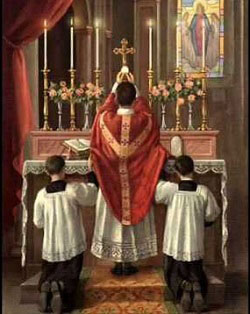 There are presently two main forms of the Roman Rite: the Extraordinary Form, which observes the liturgical books in force from around the time of Saint Gregory the Great (r. 590-604) until 1970, which was codified and extended to the universal Church in 1570, and is celebrated entirely in Latin; and the Ordinary Form, which was first offered for use in the Church in 1970, and which can be celebrated in both Latin and the vernacular.
There are presently two main forms of the Roman Rite: the Extraordinary Form, which observes the liturgical books in force from around the time of Saint Gregory the Great (r. 590-604) until 1970, which was codified and extended to the universal Church in 1570, and is celebrated entirely in Latin; and the Ordinary Form, which was first offered for use in the Church in 1970, and which can be celebrated in both Latin and the vernacular.
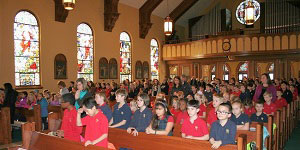 The Wednesday School Mass is an opportunity in the middle of the week to anticipate the worship of the Lord's Day and to provide the possibility for children to learn throughout their time here how to engage in that full, conscious and active participation that Vatican II calls for.
Of course, the purpose of the liturgy is not principally didactic (to teach), but latreuic (to worship).
While we are able to teach children to appreciate the riches of their Catholic liturgy in age-appropriate ways, they are still able to engage in worship according to their different capacities as they progress through that learning process.
Learning about the liturgy is a life-long process, but we can always participate in the Mass in some way at whatever stage in life we find ourselves.
The Wednesday School Mass is an opportunity in the middle of the week to anticipate the worship of the Lord's Day and to provide the possibility for children to learn throughout their time here how to engage in that full, conscious and active participation that Vatican II calls for.
Of course, the purpose of the liturgy is not principally didactic (to teach), but latreuic (to worship).
While we are able to teach children to appreciate the riches of their Catholic liturgy in age-appropriate ways, they are still able to engage in worship according to their different capacities as they progress through that learning process.
Learning about the liturgy is a life-long process, but we can always participate in the Mass in some way at whatever stage in life we find ourselves.
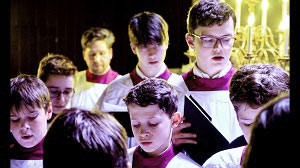 According to the Second Vatican Council's
According to the Second Vatican Council's 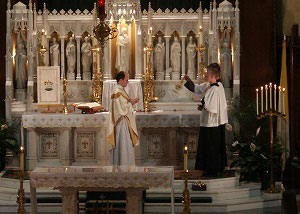 Likewise, art and music is not a peripheral part of our Catholic worship, but integral to it. The time a Catholic school invests in sacred music is a crucial component of its Catholic identity, because sacred music is part and parcel of that worship which is the source and summit of Catholic life.
Prince of Peace is not a choir school where the main focus is on music.
It is a normal parochial school with a commitment to academic excellence, an excellence which encompasses faith and reason, of all that is both old and new in learning.
But its Catholic identity requires it to see the arts, and in particular their relation to Catholic worship, as central, and not accidental to education.
Likewise, art and music is not a peripheral part of our Catholic worship, but integral to it. The time a Catholic school invests in sacred music is a crucial component of its Catholic identity, because sacred music is part and parcel of that worship which is the source and summit of Catholic life.
Prince of Peace is not a choir school where the main focus is on music.
It is a normal parochial school with a commitment to academic excellence, an excellence which encompasses faith and reason, of all that is both old and new in learning.
But its Catholic identity requires it to see the arts, and in particular their relation to Catholic worship, as central, and not accidental to education.
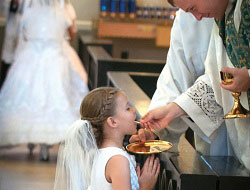 Holy Communion is distributed either under one form, of bread alone; or by intinction, by the Sacred Host being dipped by the minister in the Precious Blood.
Intinction, by its nature, means that the Host must be placed directly on the tongue of the communicant, because it is dripping with the Precious Blood (RS 104).
The normative practice of the Roman Rite is for Holy Communion to be received directly on the tongue.
Holy Communion is distributed either under one form, of bread alone; or by intinction, by the Sacred Host being dipped by the minister in the Precious Blood.
Intinction, by its nature, means that the Host must be placed directly on the tongue of the communicant, because it is dripping with the Precious Blood (RS 104).
The normative practice of the Roman Rite is for Holy Communion to be received directly on the tongue.